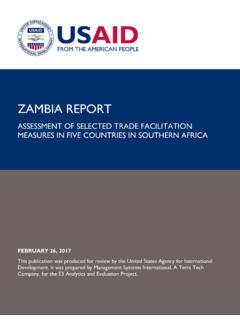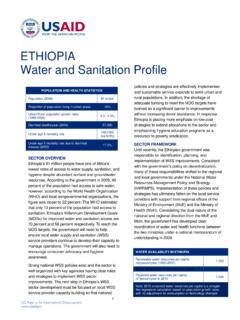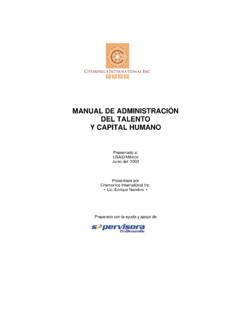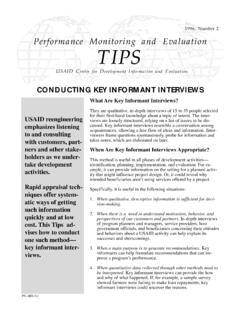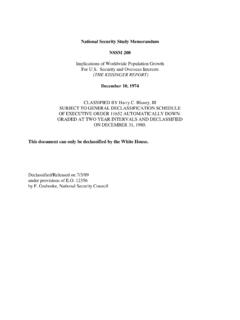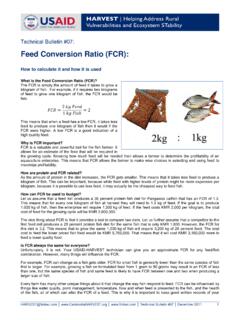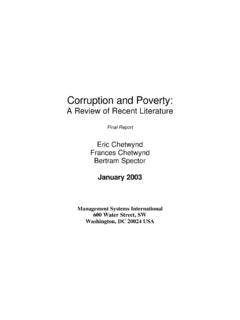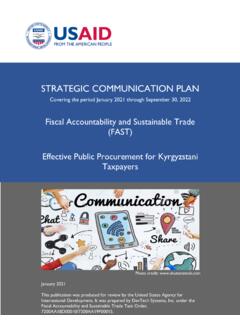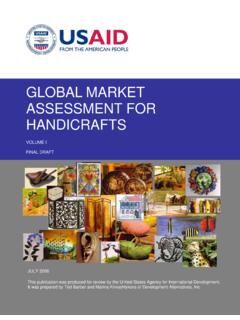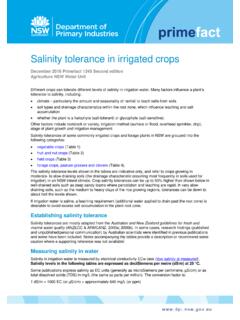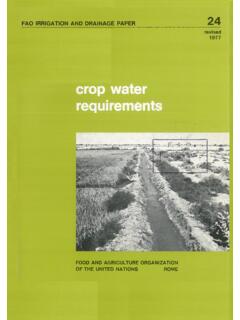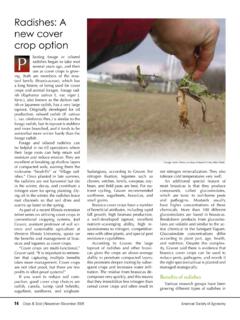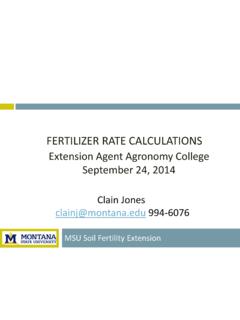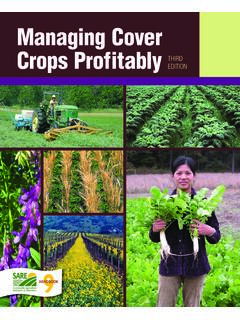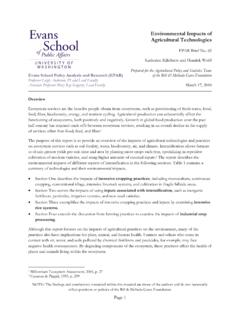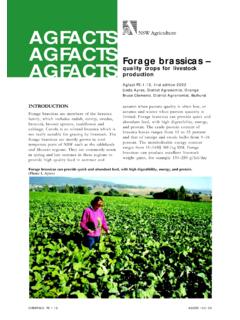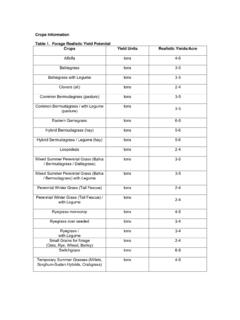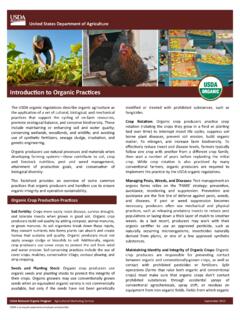Transcription of SILAGE MAKING FOR SMALL SCALE FARMERS
1 SILAGE MAKING FOR SMALL SCALE FARMERS FOOD AND AGRICULTURE ORGANIZATION OF THE UNITED NATIONS 2 How to improve the nutrition of FARMERS milking animals when each family keeps only one dairy cow? During the cold, continental winter, the major fodders available are wheat or maize straw, together with hay and concentrated feeds. As a minimum, it is essential to provide a green fodder supplement to enhance rumen function for bovine animals. Therefore, one should develop winter fodder crops. For smallholder FARMERS with limited production capacity, finding enough feed in the winter months to maintain good milk production is always a problem. Many are forced to buy hay, concentrates or SILAGE just to keep their animals alive and are unable to benefit due to the higher prices paid for animal feed in the winter months.
2 What is SILAGE ? forage which has been grown while still green and nutritious can be conserved through a natural pickling process. Lactic acid is produced when the sugars in the forage plants are fermented by bac-teria in a sealed container ( silo ) with no air. forage conserved this way is known as ensiled forage or SILAGE and will keep for up to three years without deteriorating. SILAGE is very palatable to livestock and can be fed at any time. Why SILAGE not hay? Forages can be made into hay to conserve the nutrients, especially protein, before they decline in the plant. However it is often too wet to dry the successfully and special machinery, has to be used to assist the forage to dry quickly.
3 forage crops such as maize, are too thick-stemmed to dry successfully as hay. SILAGE is considered the better way to conserve forage crops. A forage crop can be cut early and only has to have 30% dry matter to be ensiled successfully. There is no need to dry out the plant material any more than that, so wet weather is not such a constraint as it is with MAKING hay. SILAGE MAKING is long practiced by the larger agri-cultural sector, but the production method relies on heavy equipment and large production, in order to dig or build storage pits and to compress the green mass, putting it beyond the reach of smallholder FARMERS . Advantages: Introduction Disadvantages: SILAGE is not interesting for marketing as its value is difficult to be determined.
4 It does not allow longer transportation; The weight increases manipulation costs; Has considerably lower vitamin D content com-pared to hay. Stabile composition of the feed ( SILAGE ) for a longer period (up to 5 years); Plants can be harvested at optimal phase of development and are efficiently used by live-stock. Reduction of nutrient loses which in standard hay production may amount to 30% of the dry matter (in SILAGE is usually below 10%); More economical use of plants with high yield of green mass; Better use of the land with 2-3 crops annually; SILAGE is produced in both cold and cloudy weather; The fermentation in SILAGE reduces harmful nitrates accumulated in plants during droughts and in over-fertilized crops.
5 Allows by-products (from sugar beat proc-essing, maize straw, etc.) to be optimally used; Requires 10 times less storage space compared to hay; Maize SILAGE has 30-50% higher nutritive value compared to maize grain and maize straw; 2 kg of SILAGE (70% moisture) has the equal nutritive value of 1 kg of hay. Principle of SILAGE MAKING At harvest, plant cells do not immediately die ; they continue to respire as long as they remain ade-quately hydrated and oxygen is available. The oxygen is necessary for the physiological process of respi-ration, which provides energy for functioning cells. In this process, carbohydrates (plant sugars) are con-sumed (oxidized) by plant cells in the presence of oxygen to yield carbon dioxide, water and heat: sugar + oxy-gen carbon dioxide + water + heat Once in the silo, certain yeasts, molds and bacteria that occur naturally on forage plants can also reach populations large enough to be significant sources of respiration.
6 In the SILAGE mass, the heat generated during respiration is not readily dissipated, and therefore the temperature of the SILAGE rises. Although a slight rise in temperature from 80 to 90 F is acceptable, the goal is to limit respiration by eliminating air (oxygen) trapped in the forage mass. Some air will be incorporated into any silo during the filling process, and a slight increase in SILAGE tem-perature is l kely. These temperature increases can clearly be limited by harvesting at the proper mois-ture content and by increasing the bu k density of the SILAGE . Generally, it is desirable to limit respiration during the fermentation process by using common sense techniques that include close inspection of the silo walls prior to filling, harvesting the forage at the proper moisture content, adjusting the chopper prop-erly (fineness of chop), rapid filling, thorough packing, prompt sealing and close inspection of plastics for holes.
7 Ideally, corn SILAGE should be harvested at the moisture content appropriate for the type of silo used. Recommended moisture contents are 65 70 percent for horizontal silos, 63 68 percent for conven-tional tower silos, 55 60 percent for limited-oxygen silos, and 65 percent for silo bags. Corn SILAGE yield and quality as influenced by growth stage. Maturity Stage Moisture % Early dent 73 1/2milkline 66 3/4milkline 63 no milkline 60 Delaying harvest can reduce both the fiber and starch digest bility as the stover gets more lignified and the overmature kernels become harder and less digestible if left unbroken after ensiling. Corn that is ensiled extremely wet will ferment poorly and lose nutrients by seepage, which also has potential to damage the silo and if not contained, contaminate local water supplies.
8 Another problem with chop-ping SILAGE with too much moisture is that a larger amount of lactic acid is needed to reduce the pH. This results in a longer period of time before the SILAGE becomes fermented, producing a lower quality SILAGE . SILAGE that is too dry may result in poorly packed material, causing more mold and spoilage due to air trapped in the SILAGE . In dry, over mature corn SILAGE , the stover portion of the plant is less digestible and contains lower amounts of sugars and vitamin A. It will not pack well in the silo, more oxygen will be present and it will take longer to get through the aerobic phase into the anaerobic phase of fermentation. Nutrients will be used for respiration during the aerobic phase, the temperature of the SILAGE will increase and possibly burn.
9 Dry matter and moisture The approximate moisture level of chopped SILAGE can be determined by means of a grab test. Squeeze the chopped forage tightly into a ball for 20 to 30 seconds, and then release quickly. For-age chopped into 3/8 to 1/2-inch pieces should be used. Dry matter is the most important factor for production of good quality SILAGE . The optimal quality SILAGE is produced from components with dry matter contents ranging between 30 and 35%. In the following table the percentage of moisture in different parts of the maize plant are shown, as well as the ideal time for harvest for SILAGE preparation. Condition of the forage ball ball holds its shape and there is considerable free juice ball holds its shape but there is very little free juice ball falls apart slowly and there is no free juice ball falls apart rapidly Approximate moisture content Over 75% 70 to 75% 60 t0 70 % Below 60 % Parts of plant Grain Cobs Leaf Stem Cob sheets Dry matter in early wax ripening phase (%) 33 8 22 29 8 Dry matter in early wax ripen-ing phase (%) 42 9 19 24 6 Increased moisture or lack of dry matter in SILAGE components should be avoided when possible, as the activity of the lacto-acidic bacteria is decreased and the activity of the butyric acid producing bacteria is increased.
10 The optimal quantity of dry matter is achieved in the last phase of vegetation of the plants. When the weather conditions do not allow timely harvest, resulting in too wet or too dry SILAGE materials, the desired moisture can be achieved by mixing dry and wet components. The composition of the dry and wet components is determined through use of the Pierces square as show below: Whole alfalfa, 45% Whole maize plants, 45% dry matter 30% Example: If you are producing SILAGE from whole maize plants and freshly harvested alfalfa. In the mid-dle of the square you indicate the desired dry matter contents of the SILAGE (for example 30%). On the left side of the square in the upper corner, you indicate the dry matter of the fresh alfalfa and in the lower square, the dry matter of the whole maize plant (45%).
